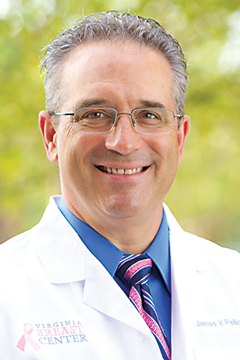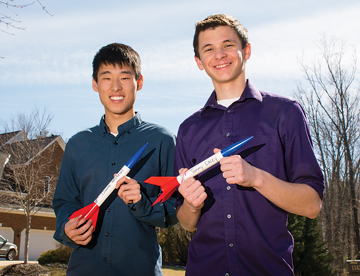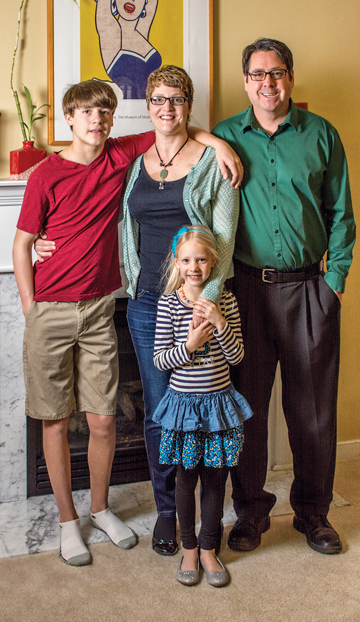Denise Gentz and her family versus breast cancer. Mom wins!
Panic shook 43-year-old Denise Gentz last year when she heard the words “you have breast cancer” from her doctor. “I thought, ‘Oh, it can’t be me. I’m only forty-three and I don’t have a strong family history of breast cancer,’” Gentz recalled. “My husband, Mark, and I felt sick. The day we were told, we were so upset.”
Denise and her husband gathered together their 12-year-old son, Alexi, and their 5-year-old daughter, Natasha, and sat them down for a serious-but-hopeful talk. “We told them the disease was curable,” she said. “My son cried. My 5-year-old didn’t understand it.”
Denise’s experience was rather unusual. Her traditional mammogram was negative as was her first ultrasound. It was the second ultrasound that picked up the large area. When her biopsy came back, it was determined she had invasive ductal carcinoma as well as lobular carcinoma. She was told she would need eight rounds of chemotherapy. That was followed by a double mastectomy, which Gentz opted for because her cancer
was so difficult to find originally. The surgery was followed by twenty-eight radiation treatments.
During the course of her battle, the oncology staff gave her the book, When Mama Wore a Hat, to read to her children to explain how tired she would be after chemotherapy. One positive takeaway from her experience was the resiliency of her children. “The kids have done amazing,” she said. “My son helped out especially with my younger daughter. We tried to keep it as normal as possible for them.”
In the past year the family has taken trips to Busch Gardens, spent time at the pool, and traveled to the beach after Denise’s last day of chemotherapy.
“It’s really hard, but you put one foot in front of the other and you just keep going. You have to deal,” she said of fighting the disease. “Having children kept me moving. You have to take care of your children and do the things a mom needs to do.”
If there was a silver lining to her cancer, it was the fact that it had a low risk of reoccurrence. Denise learned that important information after her breast surgeon, James Pellicane, MD, with Bon Secours Virginia Breast Center, conducted a molecular test called BluePrint. The test provides new information that helps determine the best preoperative treatment, such as whether or not to do chemotherapy before surgery.
A study co-authored by Dr. Pellicane and appearing in the Annals of Surgical Oncology journal showed that the BluePrint test is better than standard pathology tests in determining the subtype of a woman’s breast cancer. When doctors have a clearer idea of the subtype, they can tailor treatment more precisely.
“This test helps us hone in on the biological pathways that are driving each individual breast cancer,” Dr. Pellicane said. “Armed with that knowledge, we can make better decisions about which treatments will be most effective.”
The test will have important implications for the future of breast cancer treatment. “We will eventually end up evaluating and treating many breast cancer patients differently than we do now, especially before surgery,” Dr. Pellicane said. “That’s because we will rely on their molecular subtype, rather than just the standard results of clinical pathology tests.”

Personalized or precision medicine where medications and treatments are individualized to each person is the future of medicine. “We are not quite there yet, but we are close,” Dr. Pellicane said.
Advancements in radiation are also moving forward. Douglas Arthur, MD, vice-chairman of radiation oncology and associate director for clinical affairs at VCU Massey Cancer Center, is working towards opening two trials in the next few months, one for early-stage and one for advanced-stage disease, that will decrease the total number of radiation treatments required and drastically shorten patients overall treatment time. The radiation is used in combination with chemotherapy and surgery.
“This is an extension of our previous work,” Dr. Arthur said. “In our new trial for early-stage breast cancer, we want to be able to continue to use brachytherapy radioactive sources to treat patients in only two to three days. The general theme is to use the same effective radiation, but do it quicker, so patients can move on with their lives and additional treatment if necessary. It makes dealing with treatment a little easier.”
The fight against breast cancer has been brought to the forefront thanks to cutting-edge research and organizations such as Susan G. Komen. Thirty years ago, no one talked about breast cancer. Now because of improvements in early detection, there has been a 34 percent decline in breast cancer mortality since 1990. There are more than 2.9 million breast cancer survivors in the United States and that is the largest population of all cancer survivors.

Today, a woman diagnosed with stage 1 breast cancer, for example, has a 5-year relative survival rate of 99 percent if it is caught early and has not grown outside the breast.
Heather Hannon, MSN, RN, is a breast cancer nurse navigator for HCA Virginia’s Thomas Johns Cancer Hospital. In her position supporting people as they move through the healthcare continuum of doctor’s offices, outpatient service, clinics, insurance and payment systems, Hannon has also witnessed exciting improvements since she started in the field seventeen years ago. She notes tomosynthesis (3D mammography) specifically. The 3D image allows doctors to see a thinner slice of breast tissue. “Breast cancer screening with 3D mammography, when combined with a conventional 2D mammography, has a 40 percent higher invasive cancer detection rate than conventional 2D mammography alone,” she said. “It also reduces the number of women that have to be called back by 10 to 15 percent. This is important because it means more women are spared the anxiety of having to come back in for additional imaging.”
In women with dense breast tissue, breast cancer can be more difficult to detect with mammography as the dense tissue can mask abnormalities seen on a mammogram. Studies show that for women with dense breast tissue, automated whole-breast ultrasound screening (ABUS) can find more and smaller cancers than can’t be detected by mammography alone. “It has been shown to improve breast cancer detection rates by 35.7 percent when used in conjunction with mammography,” she said.
She also points to a study out of University College London that looks at the epigenetic signature (changes in gene expression that may be involved with developing cancer) associated with breast cancer. “They found epigenetic changes on DNA that were indicative of women who were going on to develop breast cancer,” Hannon said.

Looking ahead, there is potential for a blood-based epigenetic test to identify breast cancer risk in women who do not have an inherited genetic mutation. “That research is several years down the road,” Hannon said.
With this kind of science and research ongoing, the hope is that one day other women won’t have to go through what Denise has had to endure. That said, now cancer free, Denise will tell you having breast cancer gave her a new perspective on life.
“I learned that people can handle more than they think they can and that you have to push yourself,” she said. “I learned to let the little things go. Now I appreciate the small moments so much more.”
The Susan G. Komen Central Virginia
Affiliate has the following advice for all women:
• Know your risk and your family history.
• Get screened every year, beginning at age forty.
• Know what is normal for you. If you see visual changes or feel something, get in touch with a healthcare provider.
• Make healthy lifestyle choices such as eating right and limiting the amount of alcohol you consume. It may help reduce your risk for breast cancer.
Meet the Boys Who
Blew Up Breast Cancer

Dusk was approaching. It was the perfect time to view a rocket launch and 17-year-old Sanzio Angeli and 18-year-old Dylan Whitesel were ready to put on a show. The two friends stood side-by-side as they pushed the button to attempt to launch 4,087 rockets. The ensuing glare and white smoke from the successful launch of 3,973 of the rockets put the two Chesterfield students in the Guinness Book of World Records, breaking the previous record of 3,130.
But the launch at the Chesterfield County Fairgrounds was more than a rocket record breaker. It was the culmination of the young men’s Rocket 4 the Cure fundraising event for Susan G. Komen. Thanks to their efforts, Komen received $20,155 – and some change.
The idea for the launch started coming together months before the October 26, 2014, event. The October date was chosen because of Breast Cancer Awareness Month and because battling the cancer that one in eight U.S. women will be diagnosed with in their lifetimes is a cause that was important to both teens. Whitesel’s mother, Diane, was diagnosed with breast cancer in 2008 and is still battling stage four breast cancer.
From the start, the teens had two goals for their project: to shatter the record for the most rockets launched simultaneously and to raise money for breast cancer. They succeeded in doing both.
Sanzio’s mother, Annette Angelie, wasn’t surprised that the teens’ idea involved rockets.
“Sanzio was always into rocketry,” she said. “He has been launching rockets since he was five or six years old. It’s a hobby for both guys.”
One of their hurdles early on was to find a location where they could stage the rockets and launch them. The teens first looked at both Midlothian and Clover Hill High Schools, but couldn’t get approval from Chesterfield County Public Safety Board. “They shot it down,” Sanzio said, noting that he attends the Math and Science Center at Clover Hill and Whitesel attends Midlothian High. “We looked at other locations, including the Chesterfield County Fairgrounds. We thought it was the best facility and had the most open space.”
Another consideration was cost. The teens decided to have people sponsor each rocket. The $10 sponsorship, which included a custom decal bearing the names of the sponsor’s loved ones, would cover the $5 cost of the rocket and also allow the teens to donate the same amount to the breast cancer organization Susan G. Komen.
Once their plan was in place, the teens visited Linda Tiller, executive director of the Susan G. Komen Central Virginia Affiliate. “They came to me last summer with a PowerPoint presentation to show me what they wanted to do,” she said. “They had all their plans laid out. I took a deep breath and agreed.”
Sanzio’s brother, Gino, a junior at James River High School, designed a logo for Rocket 4 the Cure as part of his contribution.
The teens’ fundraising goal of $20,000 was one of the larger goals that anyone had proposed to Tiller. “…and they were high school students. I was impressed!” she said. “They were very professional and very prepared when they came to me. One of the things I thought was amazing, is that I never even met their mothers until the day of the launch. The kids did it all themselves with great support. They drove this. That impressed the heck out of me.”
According to Tiller, the day they shot off the rockets was “the best day ever!”
Mounting the event took a great deal of people-power. Each rocket took approximately seventeen minutes to build. Launch pads had to be crafted out of wood and holes had to be drilled in them for each rocket.
The process for the launch began at the fairgrounds around seven the Saturday night before the event and it took until midnight just to set up the launch pads. The next morning, the teens and other volunteers started preparing the rockets at six o’clock. “We had to wire the rockets together by hand,” said Sanzio’s mom, Annette. “It was quite the ordeal.”
 During the building and launch segment of the project, the teens had more than 200 volunteers at multiple times, logging in over 3,000 volunteer hours. “We had tremendous help from our families, friends, and the community,” Sanzio said.
During the building and launch segment of the project, the teens had more than 200 volunteers at multiple times, logging in over 3,000 volunteer hours. “We had tremendous help from our families, friends, and the community,” Sanzio said.
“We basically had a rocket factory at our house. It was a revolving door,” Annette added. “People would come and go. Some would stay six or seven hours at a time. They would bring friends to help out. We made chili, sloppy joes, and sub sandwiches. There was always food here for people to eat. It became a very social thing. It was fun. People enjoyed it.”
Volunteers were recruited from a variety of school-related organizations such as the engineering clubs at Robious Middle School and Midlothian High School, and the Clover Hill Beta Club and National Honor Society. “We built the rockets one piece at a time,” Sanzio said.
The task of wiring took ten hours and by four o’clock on that October day everything was ready to go. Another student at Clover Hill, Michelle Marquez, had the idea to arrange the rocket launch pads in a circular pattern to get aerial pictures from a drone she and her father provided. She also asked spectators to stand in the shape of a cancer ribbon so a photo could be taken with an infrared camera from above.
About the rocket launch and the fundraising effort to help blow up breast cancer, literally, Sanzio said, “The launch was awesome. The last two hours were the most nervous, stressed out time, but also the happiest. It was the most intense couple of hours of my life. It was all very gratifying.”




